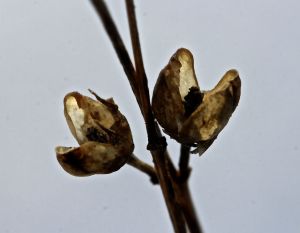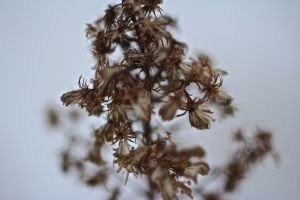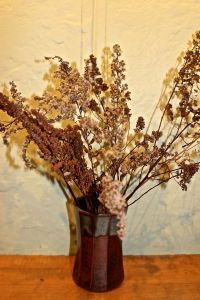Shades of brown, gray and green dominate the winterscape now that we finally have some snow. It’s those browns that frequently draw my focus as I admire the woody skeletons of bygone summer wildflowers. Of course, some call them weeds.. I’ll admit that they do grow prolifically–especially in land cleared by humans, e.g. the field and power line I frequent.
But . . . come meet a few of my winter friends.
This is Indian tobacco (Lobelia inflata). Guides say it tends to be alone, but I’ve seen it grow in colonies as well. The papery calyx is all that is left now.
Inflata refers to the inflated seedpods, which are two-chamber capsules that split open to drop their seeds.
Minute and scaly, the seeds self sow.
I struggle with the ID of this member of the mint family. Knowing it is a mint is the easy part. Notice the square stem? I believe it’s bugleweed or water horehound, but I’ve also toyed with motherwort. Either way, both feature toothy calyces that whorl around the stems. I keep flip-flopping because the dried seedpods seem larger than bugleweed, but all were on single stems and the area is known to be wet–though not consistently. Maybe knowing it’s a mint is enough.
Both hardhack (steeplebush) and meadowsweet are members of the Rosaceae family. Their dried fruit structure is known as a follicle, meaning it splits open along one line–like a milkweed. But these two plants have five follicles encircling a central point.
Showy goldenrods grow abundantly and it’s no wonder given all their seeds. They depend on the wind and my snow pants to disperse. I refer to plants that stick to my clothes as volunteers. And if they are sticking to me, then they are also sticking the fur of mammals that move about this area. Today I found deer, bobcat and squirrel tracks.
Both goldenrods and aster seeds have small, single-seeded fruits called achenes. A receptacle holds the fruits in place until they’re ready to head off on their own.
Check out the crown of hair, called a pappus, on this aster. These act like parachutes and enable the fruits to float along in a breeze, thus spreading the flowers far and wide.
While the goldenrod flowers tend to grow in dense clusters, aster flowers are found in a single arrangement.
A turn to folklore explains how the goldenrods and asters are related. Two young girls talked talked about their future. One, who had golden hair, said she wanted to do something that would make people happy. The other, with blue eyes, said that she wanted to be with her golden-haired friend. When the two girls told a wise old lady of their dreams, she gave them some magic corn cake. After eating the cake, the girls disappeared. The next day, two new kinds of flowers appeared where the girls had walked: Asters and Goldenrods.
Another way to identify goldenrod in the winter is to look for these galls. The goldenrod ball gall, on the left, is a round gall in the middle of a stem. In the spring, the Goldenrod gall fly lays her eggs on the stem. Hatched larvae chew their way into the stem and the gall starts to develop. The other is a Goldenrod bunch gall created by a tiny fly called the Goldenrod gall midge. It looks like a mass of tiny leaves. While it stops the main stem from growing, tiny branches extend outward.
Though not an insect, I did find a spider on the snow today.
And then I came in, bringing a few finds with me. My guy is lucky–bouquets come cheap around these parts.
Some call them weeds. I call them volunteers who add beauty in any season.

















Love the part of each day that I spend with your wonderings, photos, and narrative. One tweek today: /Spirea/ is a genus in the family /Rosaceae./ I miss doing winter weeds with the program and I am grateful for your ‘review’ of the terms and the beauty. best, susan
LikeLiked by 1 person
Thanks for the catch, Susan, and for following along.
LikeLike
Great post and great photos! Time for me to review all that winter weed vocabulary. I made Christmas bouquets of evergreens, dried beech and oak leaves, winterberry and winter “weeds.” Much nicer than a grocery store bouquet of dyed carnations!
LikeLiked by 1 person
I know, Andrea–the vocabulary takes a bit, but then it starts to click. Every year, more vocab makes more sense to me.
LikeLike